Above: A man cuts cocoa pods on a cocoa farm in the village of Andou M’batto, in the region of Alepe in Ivory Coast on Sept. 21. Credit: Thierry Gouegnon for HuffPost
The endless global appetite for chocolate has bitter consequences in West Africa, especially in Ivory Coast and Ghana, where most of the world’s cocoa originates. The landscape in the region has been transformed, with expanses of forests razed to make way for cocoa bean plantations, which are eating up protected land and national parks and destroying once-thriving ecosystems.
Cocoa production, catering especially to a wolfish demand for candy in Europe and the U.S. (each American consumes about 9.5 pounds of chocolate a year; in Switzerland, 19.8 pounds) has led to the decimation of forests.
The effects have been devastating. Rainfall is down, temperatures have risen and biodiversity has dwindled in one of the most naturally rich forest habitats in the world, home to endangered animals including chimpanzees, elephants and pygmy hippos. Forests once loud with animal sounds are now graveyards. The soil, overused, has lost its fertility.
But there is a glimmer of hope for the region. Though globally deforestation is at terrifyingly high rates, with West Africa seeing some of the worst effects, Ivory Coast and Ghana seem to be rebounding, according to new data. Signs point to the concerted efforts of governments, nongovernmental organizations and multinational corporations to combat the forest loss driven by cocoa cultivation and to promote more sustainable — and more humane — systems of agriculture.
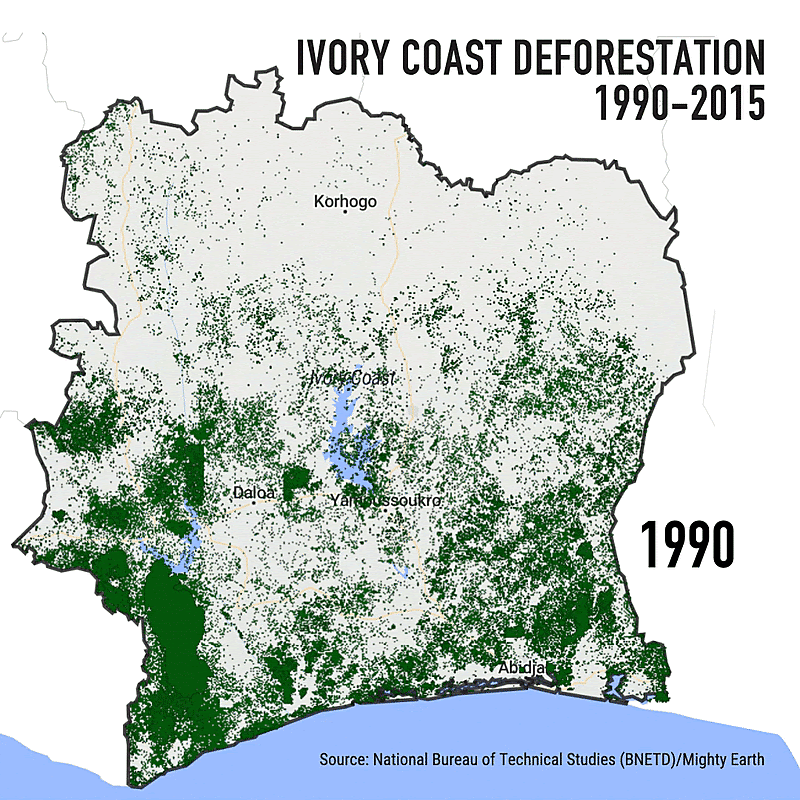
Ivory Coast, which supplies most of the world’s cocoa (40%) but makes only a fraction of the profit (5%), has been particularly hard hit by deforestation. In less than a century, the country has lost almost 85% of its forest cover ― an area about the size of Louisiana ― as poor communities settled in some of its protected areas, clearing trees to farm cocoa. By 2018, approximately 2.5 million hectares of its forest cover was left from 16 million hectares in 1960, according to UN-REDD, a United Nations climate program.
Over the course of 2018, Ivory Coast saw further alarming levels of forest loss. The rate rose by 26%, compared with the previous year. Figures were even higher in neighboring Ghana, where the forest loss rate jumped by 60% ― higher than any other tropical country in the world (although Ghana’s government disputes the number). Much of that loss is attributed to cocoa farming.

But this year’s figures paint a more hopeful picture, with annual tree cover loss rates slowing in both countries over 2019, according to satellite data obtained by University of Maryland researchers and published by Global Forest Watch in June 2020. The two countries went from the worst performing to the best ― both cutting their rates of tree loss by more than 50% compared with 2018.
It’s too early to say for certain what is behind the decline, but the World Resources Institute (WRI), a nonprofit based in Washington, D.C., that leads Global Forest Watch, points to a bundle of anti-deforestation measures implemented over the past few years.
“The 2019 decline is a welcome signal the initiatives ... and pledges by both countries and major cocoa and chocolate companies to end deforestation could be having an impact,” the WRI wrote on its website. Although only time will tell if it’s a pattern or a blip ― “we like to wait a few years to see if it’s a sustained trend,” Caroline Winchester, a WRI researcher told HuffPost ― there is, at last, some hope that the forests can be saved.
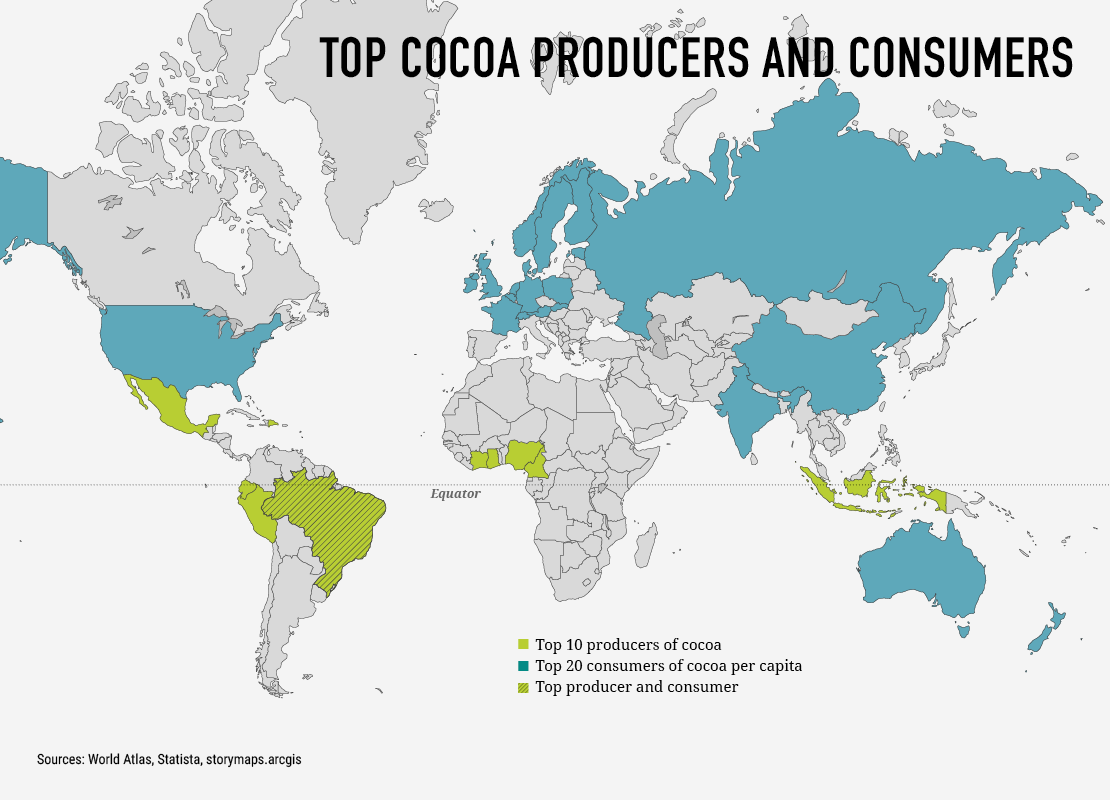
Ghana and Ivory Coast have agreed to a swath of anti-deforestation measures over the years. Some have yielded better results than others.
Both are committed to REDD+, a United Nations emissions reduction program that sees resource-rich, developing nations get paid, directly or in carbon credits, for not cutting down or degrading their forests.
Ivory Coast also signed the U.N. New York Declaration on Forests in 2014, committing to restore a fifth of lost forest and reduce deforestation by 80% by 2030. In the years since, however, global deforestation has risen and there’s little evidence to suggest that these commitments have led to significant progress on curbing deforestation. Critics chalk that up to management and funding problems.
At the end of last year, the Ivory Coast government partnered with startup Seedballs, which focuses on reforestation efforts, to plant 1 million trees across the country.
Big chocolate companies ― whose reputations have been long-soiled for failing to trace and remove illegal cocoa sources (cocoa grown on protected areas or with child labor) ― have also scrambled to act. Manufacturers like Swiss giant Nestlé and the Chicago-based Mars Wrigley, the biggest chocolate company in the world, as well as cocoa traders, such as U.S. food company Cargill, are committing to programs supporting sustainable production.
One of the most prominent is the Cocoa & Forests Initiative, launched in 2017. It’s a public-private partnership between the governments of Ivory Coast and Ghana and 35 cocoa companies, with the aim of ending deforestation and restoring forests. Run by the World Cocoa Foundation (WCF), the initiative is training farmers on “climate-smart” agriculture: planting cocoa under the shade of old trees instead of felling them; diversifying from cocoa to other food crops to increase soil fertility; and modernizing the old, back-breaking cocoa farming methods.
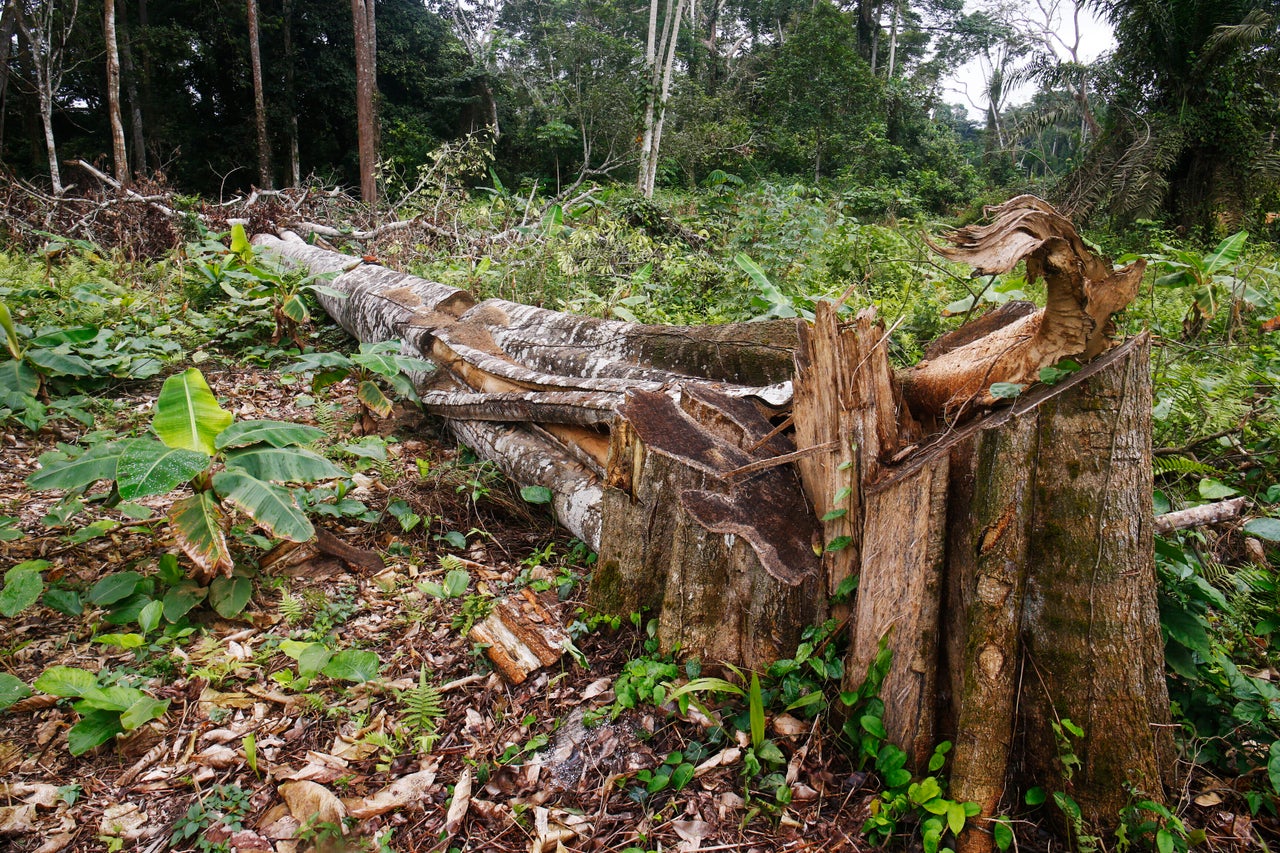
The full-sun technique many farmers use requires the removal of surrounding shade trees when planting cocoa, a method that drives deforestation. Meanwhile, planting just a single crop depletes the soil.
Deli Diomande, a 42-year-old farmer in Mangouin, western Ivory Coast, has farmed cocoa for 10 years. “When I started planting cocoa, the soil was not so degraded, but when the sun comes now, the process is grueling,” he said. Diomande told HuffPost that hotter temperatures kill half of his cocoa trees most seasons. Where farmers once harvested several tons of cocoa beans, they barely harvest a single ton now, he said.
Under the initiative, the World Cocoa Foundation is also partnering with governments to map farms in the region so deforestation can be monitored in real time.
The partnership reported for the first time this year. There was “notable progress measured on agroforestry, traceability, farmer training, policy and collaboration,” said Ethan Budiansky, WCF’s global environment director. “More than four million trees have been planted and one million farms have been mapped to improve traceability and eliminate deforestation from supply chains.”
It’s possible that programs like the Cocoa & Forests Initiative “may be starting to have a positive effect because it’s a collective agreement,” said Winchester, of WRI, but she added that it will take years of monitoring to be able to say for sure.
Experts warn that deforestation remains rampant despite programs and laws against it and that government action at times has led to mass evictions of families from protected lands. Meanwhile, reforestation efforts are hampered by a lack of government funding and infrastructure.
One of the more recent and controversial programs in Ivory Coast is a 2018 policy meant to regenerate “classified forests” (supposedly protected areas) that had been illegally turned into cocoa farms by handing them to big chocolate manufacturers. The idea is that because the land is already degraded, it’s better to put it into companies’ hands to run sustainably as legal agro-forestry reserves.
Industry experts are skeptical. “How would chocolate companies who have contributed to deforestation be able to manage forests in a sustainable manner? I just don’t see it happening,” said Michiel Hendriksz, director of FarmStrong Foundation, a Swiss nonprofit working to simplify sustainable farming methods in the region. Rights groups have also kicked against the policy, which they say will displace hundreds of thousands of people living there and amount to human rights abuses.
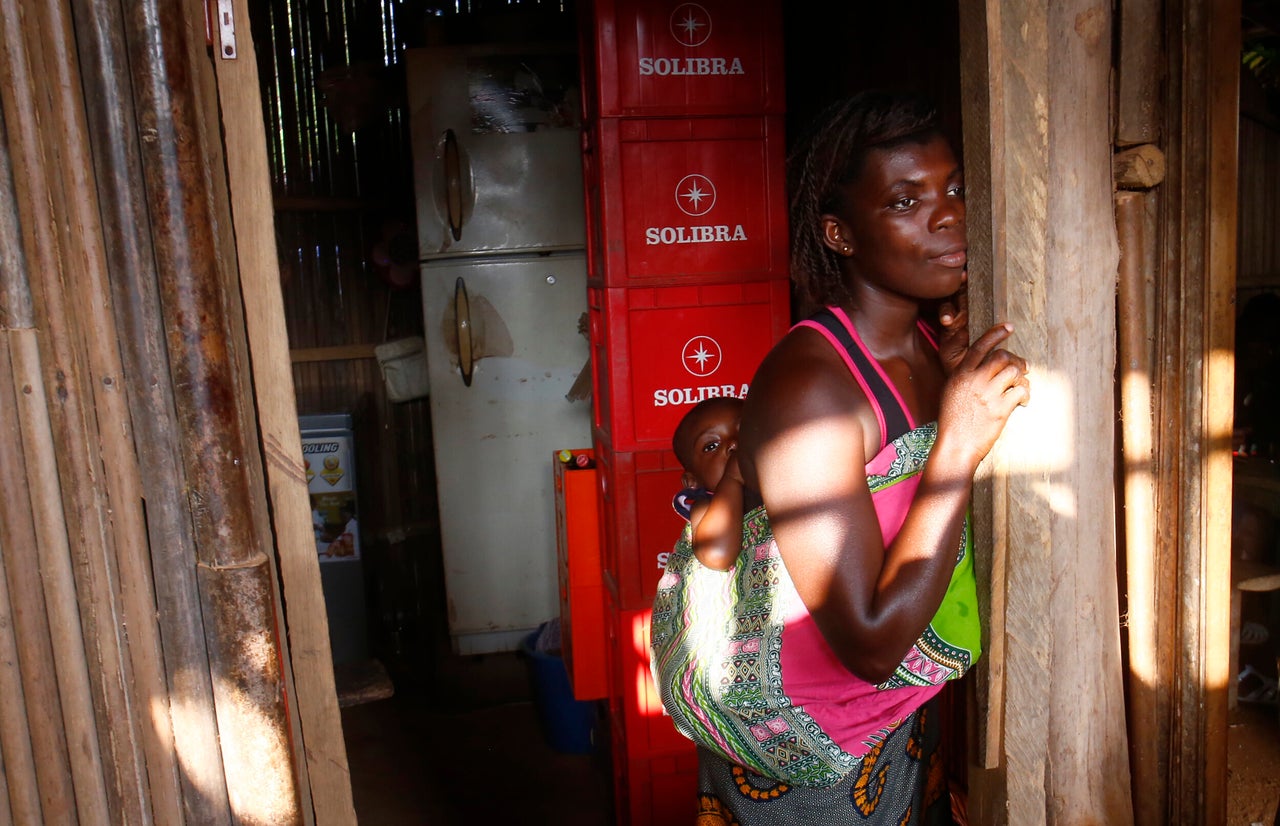
Despite the falling rates of deforestation reported this year, campaigners told HuffPost that the situation on the ground is still bad and will remain so as long as governments and companies fail to address one of the biggest drivers of deforestation in the region: biting poverty.
The booming chocolate industry is worth more than $100 billion, but the largest profits are concentrated in manufacturing and distribution businesses based in the U.S. and Europe. The trade is far from lucrative for cocoa farmers. The bitter irony is that many would never be able to afford the chocolate bars their beans produce.
“I’ve worked in war zones like Sierra Leone and Iraq, and I’ve never seen worse poverty,” Etelle Higonnet, a researcher with U.S. environmental monitoring group Mighty Earth, told HuffPost. “If you don’t pay people a living income, how are they supposed to send their kids to school? Of course they chop down trees.”
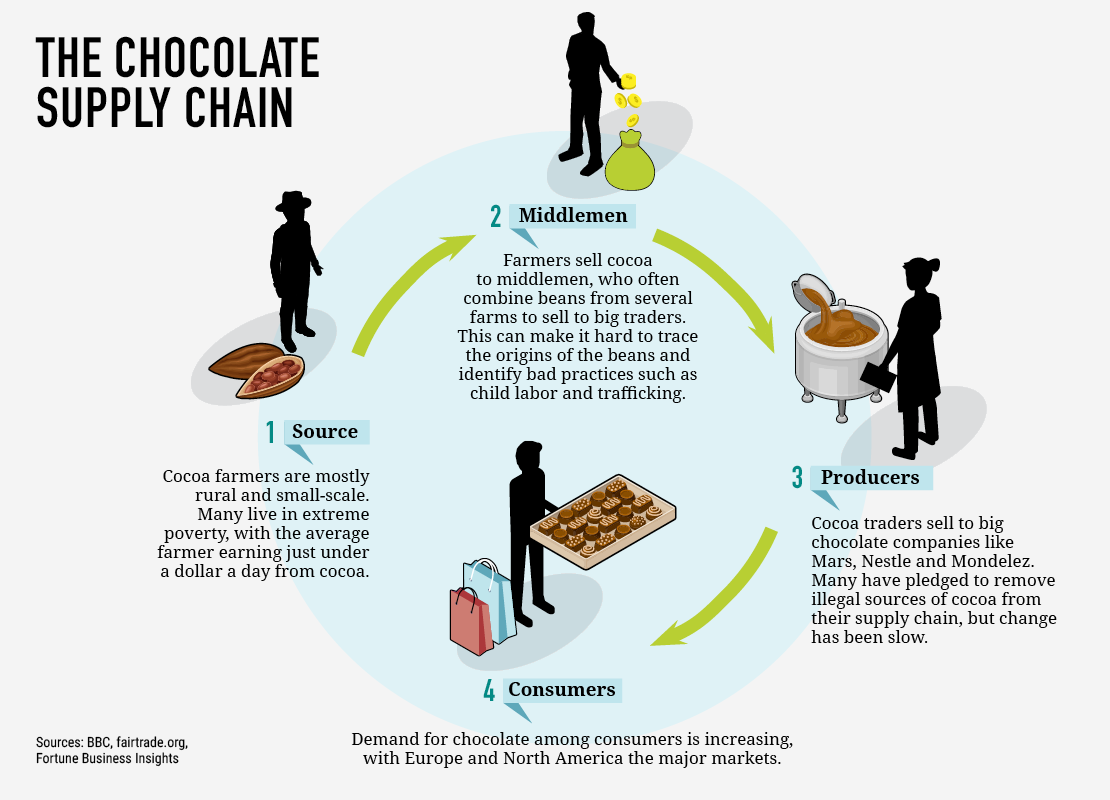
Higonnet said that, although deforestation appears to be slowing, any successes recorded may backslide if farmers continue to earn poorly — pressuring them to clear even more land and plant even more cocoa — and if supply chains remain untraceable.
Cocoa farmers, mostly rural, small-scale producers, are at the very bottom of the global chocolate supply chain. Middlemen, who buy the cocoa off them and then sell the beans to big traders such as Cargill (which, in turn, sell to manufacturers like Mars), make a better profit. This layered supply chain can make the origins of cocoa hard to trace, and some of these middlemen, Higonnet said, are the source of the “worst cocoa with trafficking and slavery, child labor, and deforestation.” Approximately 890,000 child laborers work in cocoa farming, according to the 2018 Global Slavery Index.
According to Ousmane Attai, a journalist and cocoa specialist in Ivory Coast, “the situation is stagnant” when it comes to better rights for farmers. He blames Ivory Coast’s ambitions to remain the leading producer of cocoa rather than to grow food crops for local consumption, which would earn farmers more income and give them fewer incentives to clear forests for cocoa farms.
There are fears that the pandemic may cause an uptick in deforestation rates as monitoring pauses. With schools shut between March and May, child labor numbers have likely increased, too, said a cocoa expert working in Ivory Coast who preferred to stay anonymous.
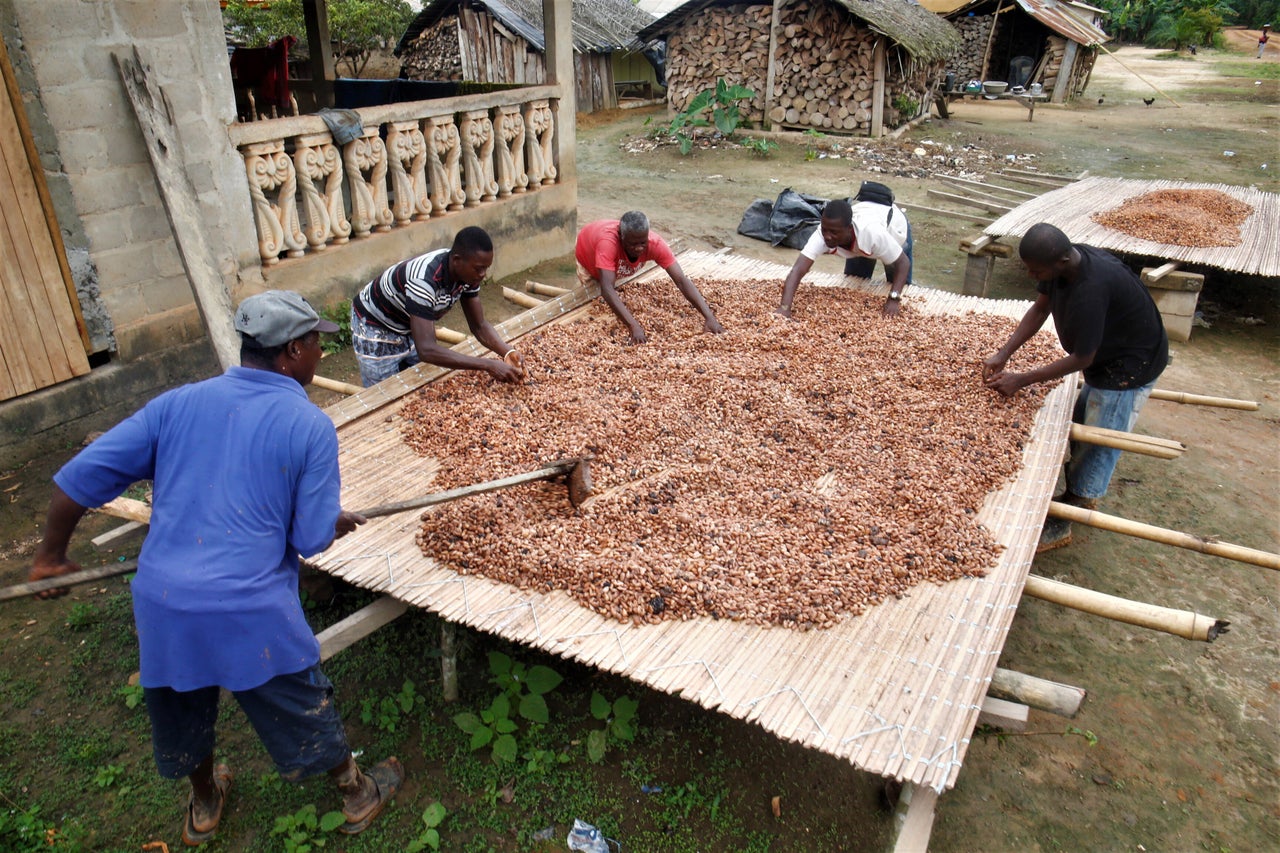
Ivory Coast and Ghana have tried to raise farmer income and consequently reduce deforestation. In 2019, the two countries banded together to set standard prices for cocoa at a minimum of $2,600 per ton with an additional “living income” of $400 per ton for farmers. The extra fees — to be enforced for the 2020-21 growing season — will go into a “stabilization fund” intended to protect farmers from cocoa price fluctuations.
But a relatively small price uplift won’t be enough to fight the poverty that’s linked so closely with deforestation. Government corruption and inaction must also be addressed, campaigners say. Higonnet said little has been done by way of prosecutions despite extensive land mapping exercises that identify deforestation hot spots stemming from farming or illegal felling.
The Ghana Cocoa Board, the government agency that fixes prices, and Ivory Coast’s Cocoa and Coffee Council marketing board could not be reached for comment.
――
Environmentalists and big chocolate companies still sound hopeful notes.
As awareness increases of the environmental and human rights abuses happening in West Africa to make chocolate, companies are setting goals on transparency ― with some performing better than others, according to a 2019 scorecard by the nonprofit Green America.
Olam Cocoa, a leading cocoa supplier to big chocolate companies, this week announced that it recorded “100% traceability” in its global supply chain ― meaning it can track cocoa beans back to their farm of origin.
Nestlé says it has mapped 75% of its cocoa back to the farm and hopes to reach 100% this year. It also said it is seeing some progress in monitoring and disengaging child laborers in its cocoa sources. Mars Wrigley told HuffPost that its partial supply chain list will soon be upgraded to a full supply report and that it aims to map and trace 100% of its cocoa from Ivory Coast and Ghana down to farms by 2022.
Mondelez, the Illinois-based snack giant behind Oreos and Toblerone, says it has mapped 85% of the farms it gets its cocoa from in Ghana, Ivory Coast and the Dominican Republic and says it is halfway to its 2025 aim to work only with farmers registered under its in-house sustainability program.
Companies intensifying cocoa source tracing will move the needle on progress, Higonnet said. The fear of sanctions and of having their cocoa rejected could motivate more farmers to support deforestation-free farming.
Battling deforestation is “difficult and complex,” said Budiansky, the WCF environment director. He said the organization has plans to accelerate farm mapping progress to monitor more deforestation hot spots.
Finding a lasting solution to deforestation, Higonnet said, requires all hands on board: governments to enforce laws better, big chocolate manufacturers to ramp up farmer education on zero deforestation and remove bad cocoa sources, and you, the consumer, to support sustainable manufacturers by paying a bit more for your chocolate bar.
“In a way, we’ve made a lot of progress, but I feel like the progress doesn’t matter so much until you go all the way,” Higonnet said. “We’re so far from the finish line, which is the cocoa companies and the government cracking down on deforestation. Everyone in the supply chain should be responsible. If you could spend three cents more so there’s no deforestation and child labor, you should do that. You should pay that extra money to do the right thing.”
HuffPost’s “Work in Progress” series focuses on the impact of business on society and the environment and is funded by Porticus. It is part of the “This New World” series. All content is editorially independent, with no influence or input from Porticus. If you have an idea or tip for the editorial series, send an email to thisnewworld@huffpost.com.